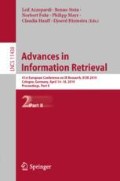Abstract
Recently, neural network architectures have outperformed traditional methods in biomedical named entity recognition. Borrowed from innovations in general text NER, these models fail to address two important problems of polysemy and usage of acronyms across biomedical text. We hypothesize that using a fully-contextualized model that uses contextualized representations along with context dependent transition scores in CRF can alleviate this issue and help further boost the tagger’s performance. Our experiments with this architecture have shown to improve state-of-the-art F1 score on 3 widely used biomedical corpora for NER. We also perform analysis to understand the specific cases where our contextualized model is superior to a strong baseline.
Access this chapter
Tax calculation will be finalised at checkout
Purchases are for personal use only
References
Doğan, R.I., Leaman, R., Lu, Z.: Ncbi disease corpus: a resource for disease name recognition and concept normalization. J. Biomed. Inform. 47, 1–10 (2014)
Huang, Z., Xu, W., Yu, K.: Bidirectional LSTM-CRF models for sequence tagging. arXiv preprint arXiv:1508.01991 (2015)
Jagannatha, A.N., Yu, H.: Structured prediction models for RNN based sequence labeling in clinical text. In: Proceedings of the Conference on Empirical Methods in Natural Language Processing, vol. 2016, p. 856. NIH Public Access (2016)
Kim, J.D., Ohta, T., Tsuruoka, Y., Tateisi, Y., Collier, N.: Introduction to the bio-entity recognition task at JNLPBA. In: Proceedings of the International Joint Workshop on Natural Language Processing in Biomedicine and its Applications, pp. 70–75. Association for Computational Linguistics (2004)
Lafferty, J., McCallum, A., Pereira, F.C.: Conditional random fields: probabilistic models for segmenting and labeling sequence data (2001)
Lample, G., Ballesteros, M., Subramanian, S., Kawakami, K., Dyer, C.: Neural architectures for named entity recognition. In: Proceedings of NAACL-HLT, pp. 260–270 (2016)
Leaman, R., Gonzalez, G.: Banner: an executable survey of advances in biomedical named entity recognition. In: Biocomputing 2008, pp. 652–663. World Scientific (2008)
Leaman, R., Islamaj Doğan, R., Lu, Z.: DNorm: disease name normalization with pairwise learning to rank. Bioinformatics 29(22), 2909–2917 (2013)
Li, J., et al.: BioCreative V CDR task corpus: a resource for chemical disease relation extraction. Database 2016 (2016)
Ma, X., Hovy, E.: End-to-end sequence labeling via bi-directional LSTM-CNNs-CRF. In: Proceedings of the 54th Annual Meeting of the Association for Computational Linguistics (Volume 1: Long Papers), vol. 1, pp. 1064–1074 (2016)
McCann, B., Bradbury, J., Xiong, C., Socher, R.: Learned in translation: contextualized word vectors. In: Advances in Neural Information Processing Systems, pp. 6294–6305 (2017)
Peters, M., Ammar, W., Bhagavatula, C., Power, R.: Semi-supervised sequence tagging with bidirectional language models. In: Proceedings of the 55th Annual Meeting of the Association for Computational Linguistics (Volume 1: Long Papers), vol. 1, pp. 1756–1765 (2017)
Peters, M., et al.: Deep contextualized word representations. In: Proceedings of the 2018 Conference of the North American Chapter of the Association for Computational Linguistics: Human Language Technologies, (Volume 1: Long Papers), vol. 1, pp. 2227–2237 (2018)
Pisanelli, D.M., Gangemi, A., Battaglia, M., Catenacci, C.: Coping with medical polysemy in the semantic web: the role of ontologies. In: Medinfo, pp. 416–419 (2004)
Sahu, S., Anand, A.: Recurrent neural network models for disease name recognition using domain invariant features. In: Proceedings of the 54th Annual Meeting of the Association for Computational Linguistics (Volume 1: Long Papers), vol. 1, pp. 2216–2225 (2016)
Sahu, S.K., Anand, A.: Unified neural architecture for drug, disease and clinical entity recognition. arXiv preprint arXiv:1708.03447 (2017)
Smith, L., et al.: Overview of biocreative ii gene mention recognition. Genome Biol. 9(2), S2 (2008)
Wang, X., et al.: Cross-type biomedical named entity recognition with deep multi-task learning. arXiv preprint arXiv:1801.09851 (2018)
Acknowledgements
This work was sponsored by Ministry of Human Resource Development (MHRD), and Excelra Knowledge Solutions under a UAY project.
Author information
Authors and Affiliations
Corresponding author
Editor information
Editors and Affiliations
1 Electronic supplementary material
Below is the link to the electronic supplementary material.
Rights and permissions
Copyright information
© 2019 Springer Nature Switzerland AG
About this paper
Cite this paper
Gupta, A., Goyal, P., Sarkar, S., Gattu, M. (2019). Fully Contextualized Biomedical NER. In: Azzopardi, L., Stein, B., Fuhr, N., Mayr, P., Hauff, C., Hiemstra, D. (eds) Advances in Information Retrieval. ECIR 2019. Lecture Notes in Computer Science(), vol 11438. Springer, Cham. https://doi.org/10.1007/978-3-030-15719-7_15
Download citation
DOI: https://doi.org/10.1007/978-3-030-15719-7_15
Published:
Publisher Name: Springer, Cham
Print ISBN: 978-3-030-15718-0
Online ISBN: 978-3-030-15719-7
eBook Packages: Computer ScienceComputer Science (R0)

